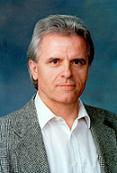|
Plenary Lecture
Uniqueness and Universality of Heat Transfer:
Challenges and Opportunities for Improving Heat Transfer Processes -
The Quest and Nature of Energy, Heat and Entropy

Prof. M. Kostic
Department of Mechanical Engineering
Northern Illinois University,
DeKalb, IL 60115,
USA
Tel.: (815)753-9975
E-mail:
kostic@niu.edu
Web site:
www.kostic.niu.edu
Abstract: This presentation focuses on philosophical and practical aspects of energy, heat and entropy, with
emphasis on reversibility and irreversibility, and a goal to establish the concept of ideal “reversible
heat transfer,” regardless that heat transfer is a typical irreversible process. Heat transfer, like any
other energy transfer, may be achieved from any-to-any temperature level, and in limit be
reversible, if temperature of an intermediary cyclic substance is adjusted as needed, using isentropic
compression and expansion. The reversible heat transfer limits are the most efficient and
demonstrate limiting potentials for practical heat transfer processes.
The heat transfer and thermal energy are unique and universal manifestation of all natural and
artificial (man-made) processes, and thus are vital for more efficient cooling and heating in new and
critical applications, including energy production and utilization, environmental control and
cleanup, and bio-medical applications. Heat transfer is known as typical spontaneous irreversible
process where all organized (structural) energies are disorganized or dissipated as thermal energy
with irreversible loss of energy potential (from high to low temperature) and overall entropy
increase. However, since reversible adiabatic expansion and compression change thermal-potential
(temperature) without heat transfer, it makes possible to have reversible heat transfer from one
thermal potential to either lower or higher, using reversible refrigeration or combined dual, powerand-
heat-pump cycles, respectively, with overall increase in efficiency.
Brief
Biography of the Speaker:
Professor Kostic's teaching and research interests are in Thermodynamics (a science of energy, the
Mother of All Sciences), Fluid Mechanics, Heat Transfer and related fluid-thermal-energy sciences;
with emphases on physical comprehension and creative design, experimental methods with
computerized data acquisition, and CFD simulation; including nanotechnology and development of
new-hybrid, POLY-nanofluids with enhanced properties, as well as design, analysis and
optimization of fluids-thermal-energy components and systems in power-conversion, utilizations,
manufacturing and material processing. Dr. Kostic came to Northern Illinois University from the
University of Illinois at Chicago, where he supervised and conducted a two-year research program
in heat transfer and viscoelastic fluid flows, after working for some time in industry.
"Kostic’s unique synergy of philosophical, theoretical, computational and experimental approach,
results in open mind, intense curiosity and sharp focus for identifying and analyzing natural and
engineering phenomena with high motivation for problem identification, troubleshooting and
solving."
Kostic received his B.S. degree with the University of Belgrade Award as the best graduated student
in 1975. Then he worked as a researcher in thermal engineering and combustion at The Vinca
Institute for Nuclear Sciences, which then hosted the headquarters of the International Center for
Heat and Mass Transfer, and later taught at the University of Belgrade in ex-Yugoslavia (*). He
came to the University of Illinois at Chicago in 1981 as a Fulbright grantee, where he received his
Ph.D. in mechanical engineering in 1984. Subsequently, Dr. Kostic worked several years in
industry. In addition, he spent three summers as an exchange visitor in England, West Germany,
and the former Soviet Union.
Dr. Kostic has received recognized professional fellowships and awards, including multiple
citations in Marquis' "Who's Who in the World" and "Who's Who in Science and Engineering."; the
Fulbright Grant; NASA Faculty Fellowship; Sabbatical Semester at Fermilab as a Guest Scientist;
and the summer Faculty Research Participation Program at Argonne National Laboratory. He is a
frequent reviewer of professional works and books in Thermodynamics and Experimental Methods.
Dr. Kostic is a licensed professional engineer (PE) in Illinois and a member of the ASME, ASEE,
and AIP's Society of Rheology. He has a number of publications in refereed journals, including
invited state-of-the-art chapters in the Academic Press series Advances in Heat Transfer, Volume
19, and "Viscosity" in CRC Press' Measurement, Instrumentation and Sensors Handbook; as well as
invited reference articles: Work, Power, and Energy in Academic Press/Elsevier's Encyclopedia of
Energy; Extrusion Die Design in Dekker's Encyclopedia of Chemical Processing; and Energy:
Global and Historical Background and Physics of Energy in Taylor & Francis/CRC Press
Encyclopedia of Energy Engineering and Technology. Professor Kostic is a member of the
Graduate Faculty at Northern Illinois University.
|